Ella travel - Sri Lanka, Asia
Ella is a picturesque town in Sri Lanka's Uva Province, located about 200 kilometers east of Colombo and perched at an elevation of 1,041 meters above sea level. Known for its cool climate and stunning scenery, Ella is a haven for nature lovers and adventurers alike. This highland town blends lush greenery, cloud forests, and tea plantations with a laid-back atmosphere.
Ella’s charm comes from its unique combination of natural beauty and iconic landmarks. Visitors are drawn to the Nine Arch Bridge, an engineering marvel surrounded by misty forests and tea fields, and Little Adam's Peak, which offers a rewarding hike with panoramic views of Ella Gap. The majestic Ravana Falls, a multi-tiered waterfall, adds to the area’s allure.. The scenic train ride from Kandy to Ella is considered one of the most beautiful journeys in the world, winding through verdant landscapes and tea plantations.
Population: Approximately 50,000 in 2024.
Economy: Ella has evolved from a quiet tea-growing village into a vibrant tourist hub in Sri Lanka, with tourism now playing a crucial role in its economy. The town’s main street has developed into a lively area filled with cafes, restaurants, and bars, offering both local and international cuisine. While the tourism sector flourishes, Ella’s tea industry remains a significant part of the local economy, with visitors able to tour nearby tea plantations and factories. Affordable transportation options, such as tuk-tuks and motorbike rentals, make it easy to explore, and the scenic Kandy to Ella train ride remains one of the most popular experiences for travelers.
Landmarks: Nine Arch Bridge, Little Adam's Peak, Ella Rock, Ravana Falls, Dhowa Rock Temple, Ceylon Tea Factory, Mahamevnawa Monastery, Uva Halpewatte Tea Factory
Sri Lanka
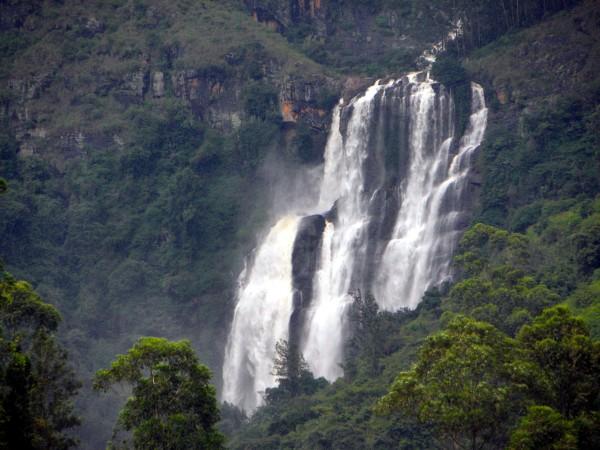
Overview of Ella
History & Cultural Influence
Ella's history is deeply rooted in Sri Lanka's colonial past, beginning as a small tea-growing village during British rule in the 19th century. The introduction of tea plantations reshaped the local economy and landscape, positioning Ella as an important tea production hub. A pivotal moment in the town's history was the opening of the Ella railway station in 1918, as part of the Colombo-Badulla line, which enhanced accessibility and sparked future growth.
Culturally, Ella's population is diverse, reflecting the ethnic mix of Sri Lanka, with a majority Sinhalese population and notable Indian Tamil communities who contributed to the development of the tea industry. The town’s cultural tapestry is also enriched by religious and historical landmarks, such as the ancient Dhowa Rock Temple and Ravana Cave, which tie local history to mythological legends like the Ramayana.
In recent years, Ella has transformed into a thriving tourist destination, driven by its natural beauty and trekking spots like Ella Rock and Little Adam’s Peak. While tourism now dominates the economy, Ella still retains its cultural essence, balancing the influx of modern amenities with efforts to preserve its traditional practices and historic sites.
Interaction with The Locals
When visiting Ella, Sri Lanka, you can expect warm and welcoming interactions with the local community, which reflects the town's diverse ethnic makeup. The population is primarily Sinhalese (66%), with significant Indian Tamil and Sri Lankan Moor communities contributing to the town’s rich cultural heritage. Visitors will find that many locals, especially those in tourist areas, speak basic English, though a few phrases in Sinhala or Tamil are always appreciated.
The general attitude towards tourists is positive, with locals known for their hospitality and eagerness to help. Many residents work in the tourism industry, offering services like guesthouses, restaurants, and guided tours, and they often enjoy sharing their culture with visitors. While Ella has embraced tourism, locals value respect for their traditions and the environment, which plays a crucial role in the town’s appeal.
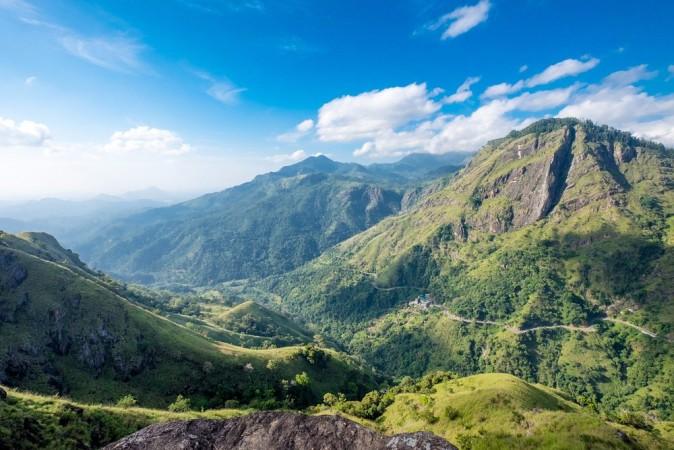
Little Adam's Peak - © Sarah D
Top Attractions in Ella
Ella, nestled in the Sri Lankan highlands, offers breathtaking attractions that captivate nature lovers and adventure seekers alike. Must-visit spots include the iconic Nine Arch Bridge, a stunning colonial-era railway bridge surrounded by lush greenery, and Little Adam’s Peak, an easy hike with panoramic views of the rolling hills and tea plantations. Don’t miss the majestic Ravana Falls, a beautiful cascading waterfall tied to local legends, and the scenic Ella Rock hike for those looking for a more challenging trek.
Nine Arch Bridge
Location: Demodara, about 3 km south of Ella town
This iconic piece of colonial-era engineering, the Nine Arch Bridge, is an architectural marvel surrounded by lush greenery. Built entirely from stone and cement without the use of steel, it spans a deep gorge and is a favorite for photographers, especially when a train is passing. Its location amidst dense jungle and tea plantations adds to its scenic beauty.
Little Adam's Peak
Location: About 2 km southeast of Ella town center
A relatively easy hike, Little Adam's Peak rewards visitors with stunning panoramic views of rolling hills, tea plantations, and distant valleys. The hike takes around 45 minutes to an hour and offers a great introduction to the natural beauty of the region, without being too strenuous. It's a perfect spot for catching the sunrise or sunset over the surrounding landscapes.
Ravana Falls
Location: About 6 km south of Ella on the Ella-Wellawaya road
Ravana Falls, one of the most popular waterfalls in Sri Lanka, cascades down from a height of 25 meters. Named after the mythical King Ravana from the Ramayana, the waterfall is not just a stunning natural attraction but also holds deep cultural significance. During the rainy season, the falls are at their most impressive, gushing with powerful streams.
Dhowa Rock Temple
Location: About 2 km from Ella town on the Badulla-Bandarawela road
This ancient Buddhist temple, dating back to the 1st century BC, is home to a striking, yet unfinished, 12-meter tall Buddha statue carved into the rock face. The temple is also known for its intricate murals and paintings that tell stories from Buddhist folklore, making it a culturally rich and historically important site to explore.
Ella Rock
Location: About 2 km north of Ella town
For those seeking a more challenging hike, Ella Rock offers a rewarding adventure. The trek takes about 2-3 hours and provides stunning views of the Ella Gap, lush forests, and sprawling tea plantations. The climb is steeper than Little Adam’s Peak, making it ideal for those looking for a more intense hiking experience.
Uva Halpewatte Tea Factory
Location: About 5 km north of Ella town
Sri Lanka's tea industry comes to life at the Uva Halpewatte Tea Factory, where visitors can tour the facilities and learn about the tea-making process, from plucking the leaves to the final cup. Surrounded by beautiful tea plantations, this factory offers a fascinating glimpse into one of Sri Lanka's most famous exports, along with the opportunity to taste freshly brewed Ceylon tea.
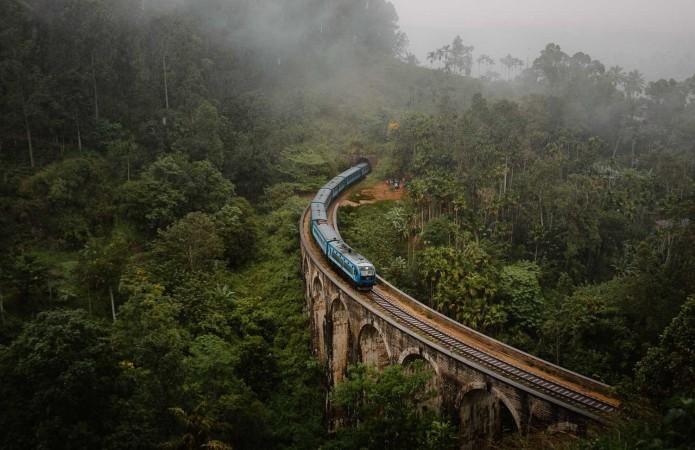
Nine Arch Bridge - © The Common Wanderer
Must-Try Dishes in Ella
When visiting Ella, be sure to try some of the must-try dishes that showcase Sri Lanka's vibrant culinary scene. Favorites include rice and curry, a flavorful meal featuring locally grown vegetables and a variety of curries, and kottu roti, a popular street food made from chopped roti, vegetables, and spices. For something sweet, indulge in curd and jaggery, a traditional dessert made from creamy buffalo curd topped with palm sugar syrup.
Rice and Curry
A staple of Sri Lankan cuisine, rice and curry in Ella takes on a fresh, flavorful twist with locally sourced ingredients. The dish often includes a variety of curries such as spicy chicken curry, black pork curry, Sri Lankan-style dhal, and cashew curry, all served with a generous portion of rice. The use of locally grown vegetables and aromatic spices makes each meal vibrant and unique, showcasing Ella's rich agricultural and spice-growing traditions.
Hoppers (Appa)
Hoppers are a beloved Sri Lankan dish made from fermented rice flour and coconut milk, resembling bowl-shaped pancakes. In Ella, you'll find both the classic egg hoppers, often served with a fried egg in the center, and string hoppers, which are thin rice noodles. Served with spicy sambols and curries, hoppers offer a delightful balance of texture and flavor, rooted deeply in the island’s culinary culture.
Kottu Roti
Kottu Roti is a street food favorite in Sri Lanka, known for its distinctive preparation sound as the roti (flatbread) is chopped and stir-fried with vegetables, eggs, meat, and spices. This dish is a staple across the country and in Ella, providing a quick, satisfying meal that's packed with flavor and showcases the energy of Sri Lanka’s vibrant street food scene.
Lamprais
Originating from Sri Lanka's Dutch-Burgher community, lamprais is a unique dish that combines rice with a mix of meat curries, eggplant curry, and boiled eggs, all wrapped in a banana leaf and baked. This dish represents the fusion of local and colonial influences on Sri Lankan cuisine and is a must-try for those seeking a complex and hearty meal.
Curd and Jaggery
A refreshing and simple dessert, curd and jaggery is made from thick buffalo curd topped with jaggery, a sweet syrup made from palm sugar. Popular in Ella and across Sri Lanka, this dessert is the perfect cooling contrast to the country’s spicier dishes, highlighting the natural ingredients that are integral to Sri Lankan sweets.
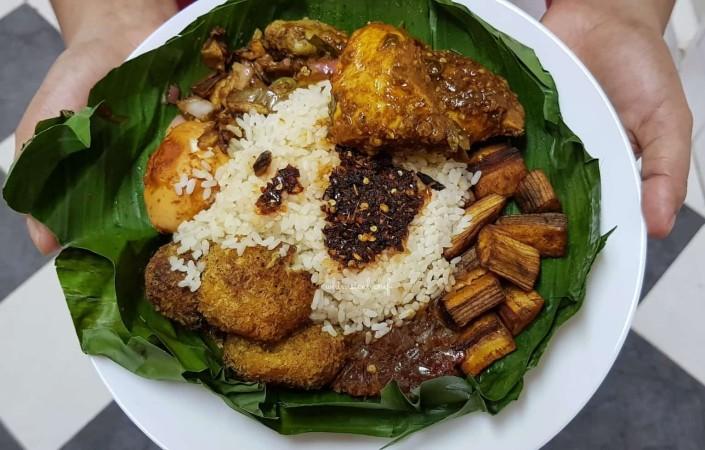
Lamprais - © whimsicalchef
Weather in Ella: Best Time to Visit
Average Temperatures
Daytime temperatures in Ella range from a comfortable 25°C (76°F) in January to a warmer 29°C (83°F) in April. At night, temperatures cool down to around 17°C (63°F) in February and rise to 19°C (66°F) by May. Overall, Ella enjoys fairly consistent temperatures throughout the year, staying between 20-30°C (68-86°F).
Rainfall
The driest months are December to March, offering plenty of sunshine. The wettest periods are May through July and October through November, with November being the rainiest, seeing about 17 rainy days. February tends to be the least rainy, with only 6 rainy days.
Best Time to Visit
The ideal time to visit Ella is from January to March or early April, during the dry season, when the weather is most pleasant for outdoor activities. December to February is also a great time but tends to attract more tourists.
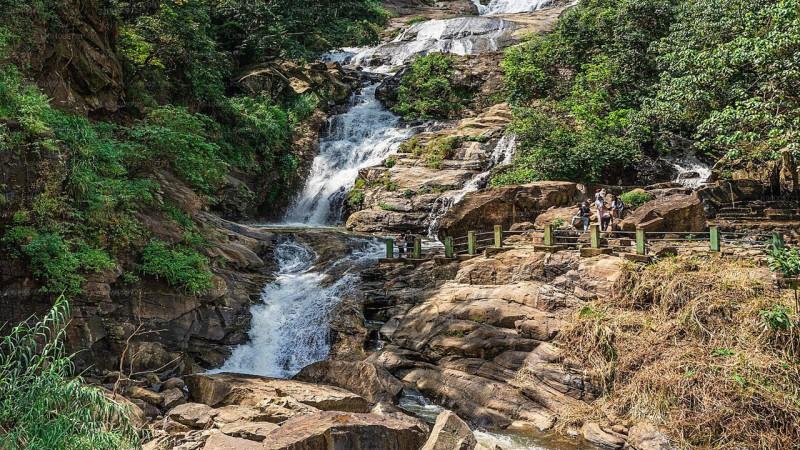
Ravana Falls - © Lakpura LLC
Festivals & Local Celebrations
Sinhala and Tamil New Year Festival
Time: Mid-April (usually 13th or 14th)
One of the biggest celebrations across Sri Lanka, including in Ella, the Sinhala and Tamil New Year brings the whole town to life. Visitors can look forward to a festive atmosphere filled with traditional New Year sweets and treats, lively games, and community competitions. You'll see locals cleaning their homes and donning new clothes, while firecrackers light up the sky, creating a joyful, inclusive celebration where everyone participates, regardless of religion.
Ella Weekly Town Fair
Time: Every Wednesday
While it’s not a festival, Ella's weekly town fair is a bustling event that offers an authentic peek into local life. Visitors can immerse themselves in the culture by exploring vibrant market stalls offering fresh produce, local products, and handicrafts. It's a fantastic opportunity to interact with friendly local vendors and soak in the lively atmosphere that showcases the rhythm of daily life in Ella.
Dova Temple Perahera
Time: May
This traditional Buddhist procession is held at the Dhowa Rock Temple and offers a colorful spectacle. Expect a grand parade featuring dancers, drummers, and elaborately adorned elephants. With Buddhist devotees joining the procession, it’s a rich cultural and spiritual experience, giving visitors a deeper insight into the religious customs and traditions that make Sri Lanka unique.
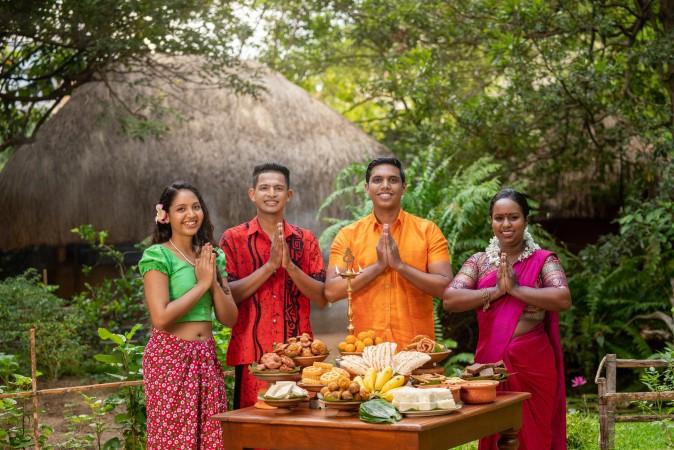
Sinhala and Tamil New Year Festival - © gather
What to Do in Ella
Hike to Little Adam's Peak
Located just outside of Ella, this moderately easy hike takes about 45 minutes to an hour and offers sweeping views of the surrounding hills and valleys. As you trek through the lush tea plantations, the path to the peak becomes more scenic, culminating in breathtaking panoramas that make the climb worthwhile.
Visit the Nine Arches Bridge
Just 3 kilometers from Ella town, the Nine Arches Bridge is a marvel of British colonial engineering. This iconic railway bridge, nestled among dense greenery, is especially picturesque when a train crosses, offering perfect photo opportunities for visitors. Walking along the tracks provides a unique view of this architectural beauty.
Explore Ravana Falls
Located 6 kilometers from Ella, Ravana Falls is a stunning waterfall plunging 25 meters down rocky cliffs. Named after the legendary King Ravana from the Ramayana epic, it's a popular spot for visitors to cool off with a refreshing swim or simply take in the surrounding natural beauty.
Trek to Ella Rock
For those seeking a more challenging adventure, the 2-3 hour hike to the top of Ella Rock is an unforgettable experience. This trek through lush greenery rewards hikers with panoramic views of the valley, tea plantations, and distant mountain ranges. It's a must-do for avid trekkers and photographers alike.
Visit Dhowa Rock Temple
Just 2 kilometers outside Ella, this ancient rock temple dates back to the 1st century. It features a 12-meter unfinished Buddha statue and intricate murals. A visit here offers a peaceful escape and insight into Sri Lanka’s deep-rooted Buddhist history and culture.
Tour a Tea Plantation
Ella is famous for its surrounding tea estates, and many offer guided tours. Visitors can explore the tea fields, learn about the production process, and sample different varieties of Sri Lankan tea. It’s a perfect opportunity to immerse yourself in one of the island’s most celebrated industries.
Relax at Ella Gap
A short walk from town, Ella Gap offers one of the most scenic viewpoints in the region. Whether you're there for sunrise or sunset, the breathtaking views of the valley and distant mountains are the perfect way to soak in the tranquil atmosphere of Ella.
Explore Ravana Cave
Located 2 kilometers from Ella, Ravana Cave is steeped in local mythology. According to legend, King Ravana used this cave to hide a captured princess. The climb to the cave is steep but offers rewarding views, combining history, folklore, and beautiful scenery.
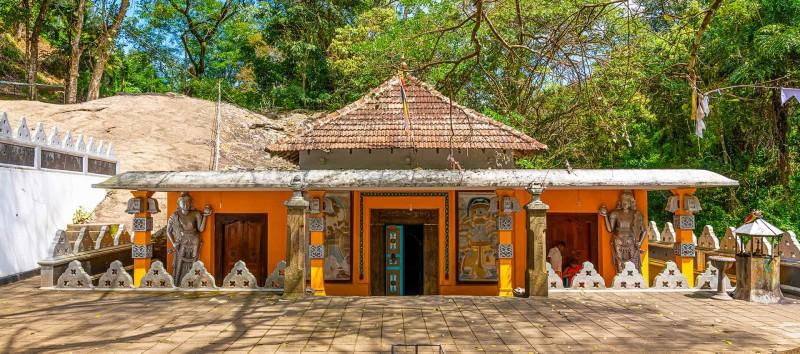
Dhowa Rock Temple - © gather
Culture Etiquette in Ella
Dress Code
Dress modestly, especially when visiting religious sites. Make sure to cover your shoulders and knees in temples and public places. Always remove your shoes and hats before entering temples or someone’s home.
Greetings and Interactions
Greet locals with “Ayubowan” (meaning "long life") while joining your palms together. Public displays of affection between men and women are frowned upon, and showing respect to elders is deeply valued.
Religious Etiquette
Women should avoid touching or sitting next to Buddhist monks. When taking photos, don’t pose with your back to Buddha statues, and avoid wearing clothes featuring images of Buddha or Hindu gods.
Body Language
The head is considered sacred, so avoid touching someone’s head. Instead of pointing with your finger, use your chin or an open palm. Never use your feet to point at people or religious objects.
Eating and Drinking
Always wash your hands before meals and use your right hand for eating or passing objects. Leaving a little food on your plate shows that you’re satisfied.
Photography
Ask permission before taking photos of people or religious sites, and be mindful that photography may be restricted in certain areas of sacred sites.
General Etiquette
It’s customary to remove your shoes before entering homes, and when offered refreshments, it’s polite to accept. Avoid drinking alcohol in public, especially during religious events.
Gift Giving
When giving or receiving gifts, use both hands. Avoid wrapping gifts in black or white, as these colors are associated with mourning.
Respect for Nature
Locals in Ella are environmentally conscious, so it’s important to respect the natural surroundings and avoid littering.
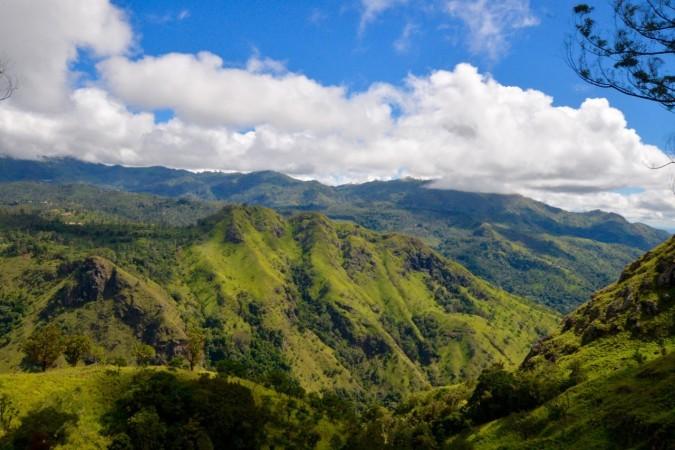
Ella Rock - © Atlas & Boots
Essential Travel Information
Getting to Ella
Train
The scenic Kandy to Ella train ride is one of the most popular ways to reach Ella. The journey takes around 7-8 hours, offering stunning views of Sri Lanka's hill country. Trains depart from Kandy to Ella daily at 8:55 am and 11:10 am. Ticket prices range from 60 to 3000 LKR depending on the class you choose.
Bus
Buses to Ella are available from major cities like Kandy, Colombo, and various coastal towns. If you're coming from the southern coast, you can take bus #31 from Matara to Bandarawela via Ella. Travel times vary, but the trip from coastal areas can take 5-6 hours.
Airport Transfer
Ella is located about 232 km from Colombo International Airport. Private taxi transfers are a convenient option, with the journey taking about 5.5 to 6 hours. Costs range between 15,000 to 26,000 LKR ($85-150) depending on the vehicle type.
Getting Around Ella
Walking
Ella town is small, and many attractions are within walking distance, making it easy to explore on foot.
Tuk-tuks
Tuk-tuks are readily available for short trips around town. Be sure to negotiate prices beforehand, which typically range from 200-400 LKR for in-town rides.
Motorbike/Scooter Rental
For those with an international license, renting a motorbike or scooter is a flexible way to explore Ella’s surroundings.
Local Buses
Local buses are available for budget travel to nearby towns, though they may run less frequently than other options.
Taxi Services
Taxis are also available for longer trips, such as airport transfers or excursions further afield.
ATM and Banking Services in Ella
ATM Availability
ATMs are available in Ella, though not as widespread as in larger cities. Most ATMs accept major international cards such as Visa, MasterCard, and American Express.
ATM Usage
ATMs in Ella are generally reliable and safe to use, with local fees ranging from 200 to 300 LKR per transaction. People’s Bank ATMs are often recommended as they tend to have lower or no fees compared to others.
Banks
Ella has several banks, including both local and international institutions. Major options include the Commercial Bank of Ceylon, People’s Bank, and potentially branches of international banks like HSBC or Standard Chartered.
Currency Exchange
Currency exchange services are available at banks and exchange bureaus in Ella. Bringing some cash in USD or EUR is advisable for better exchange rates.
Credit Cards
Credit cards are widely accepted in hotels, restaurants, and larger businesses. When paying by card, always opt to pay in local currency (LKR) to avoid unfavorable exchange rates.
Accommodation Choices
- Budget Options: Hostels and guesthouses offer affordable choices for budget travelers, with prices ranging from $10-15 USD per night.
- Mid-range Hotels: There are numerous mid-range hotels and resorts with rates between $30-50 USD per night, catering to tourists looking for comfort.
- Luxury Accommodations: High-end eco-lodges and boutique hotels are available for those seeking more luxurious stays. Expect prices of $100+ USD per night for these options.
- Homestays: Local homestays offer a more authentic experience, with prices generally falling within the budget to mid-range categories.
Location Considerations
Accommodations closer to the town center provide easy access to restaurants, shops, and attractions, while those on the outskirts offer scenic views of the surrounding hills and tea plantations.
Booking
It’s highly recommended to book in advance, especially during peak tourist seasons. Many accommodations in Ella can be booked through international online platforms for convenience.
Des articles pour vous

Explore Yala National Park - Sri Lanka Travel, Asia
Tucked away in Sri Lanka’s southeastern corner, Yala National Park is where wild nature meets deep tradition. Known worldwide for its leopard population, the park is also home to elephants, sloth bears, crocodiles, and hundreds of bird species. Beyond wildlife, Yala opens doors to a cultural landscape dotted with ancient temples, Buddhist ruins, and coastal villages. For travelers seeking more than just a safari, Yala offers a chance to explore eco-tourism, local communities, and sacred heritage sites.
Population: The Yala National Park area doesn’t have a human population.
Economy: The economy around Yala National Park thrives on a blend of eco-tourism, agriculture, and local services. Safari tours, eco-lodges, and cultural experiences drive steady income for nearby towns like Tissamaharama and Kataragama, supporting thousands of families.
Landmarks: Famous for Block I of Yala and wildlife encounters, including elephants, sloth bears, crocodiles, and exotic bird species.

Explore Galle - Sri Lanka Travel, Asia
Nestled on Sri Lanka’s southern coastline, Galle is a vibrant city where history meets the sea. Its cobbled streets, colonial architecture, and serene beaches make it a must-visit destination for travelers seeking a blend of culture, adventure, and relaxation. A UNESCO World Heritage site, Galle captivates visitors with its Dutch Fort, bustling markets, and friendly locals. Whether you’re exploring the ramparts at sunset or savoring fresh seafood by the shore, Galle promises an unforgettable journey into Sri Lanka’s heritage.
Population: Approximately 113,000 in 2023.
Economy: Galle’s economy thrives on tourism, trade, and fisheries. The city’s historic fort, colonial architecture, and coastal charm draw thousands of international visitors each year, making tourism its main economic driver. Fishing remains vital for local livelihoods, supplying fresh seafood across the region.
Landmarks: Famous for the Galle Fort, Dutch Reformed Church & Maritime Museum, and Unawatuna Beach.

Explore Bentota - Sri Lanka Travel, Asia
Nestled along Sri Lanka’s southwestern coast, Bentota is a tropical paradise that blends golden beaches, vibrant culture, and thrilling adventures. Famous for its calm waters, luxury resorts, and scenic river estuary, Bentota has become a top destination for travelers seeking both relaxation and authentic experiences. From serene beach walks at sunrise to adrenaline-pumping water sports, this coastal town offers a perfect balance of leisure and exploration. With its proximity to Colombo and Galle, Bentota is easy to reach, making it an ideal stop for both short escapes and extended holidays.
Population: Approximately 37,000 in 2023.
Economy: Bentota’s economy thrives mainly on tourism, which drives local businesses such as hotels, restaurants, and wellness retreats. The town also benefits from fishing, coconut cultivation, and handicrafts like wood carving and batik textiles. Many residents rely on the growing demand for water sports and Ayurvedic treatments, making tourism the backbone of both income and employment in the area.
Landmarks: Famous for Bentota Beach, Bentota River Safari, and Kande Vihara Temple.

Explore Mirissa - Sri Lanka Travel, Asia
Mirissa is a charming coastal town on Sri Lanka’s southern shoreline. Known for its golden beaches, turquoise waters, and vibrant marine life, it has become a must-visit stop for travelers exploring the island. Many come for whale watching, surfing, and sunset views at Coconut Tree Hill, but Mirissa offers much more than postcard beauty. The fishing boats you see anchored by the bay carry generations of stories. Local traditions, delicious cuisine, and a laid-back rhythm of life shape every visitor’s experience.
Population: Approximately 4,700 in 2023.
Economy: Mirissa’s economy is largely shaped by its coastal location. Fishing has long been the backbone of local livelihoods, with generations relying on the Indian Ocean for income. In recent decades, tourism has become the main driver of growth, thanks to whale watching, surfing, and beachside hospitality.
Landmarks: Famous for Mirissa Beach, Coconut Tree Hill, and Parrot Rock Bridge.

Explore Nuwara Eliya - Sri Lanka Travel, Asia
Tucked away in the Central Highlands of Sri Lanka, Nuwara Eliya is often called “Little England”. With its rolling tea plantations, cool misty mornings, and colonial charm, this mountain town feels like a step into another world. Travelers come here to breathe fresh air, walk through flower gardens, sip the finest Ceylon Tea, and enjoy a pace of life far from the island’s busy cities. Whether you’re drawn by scenic landscapes, heritage architecture, or the warmth of its people, Nuwara Eliya is a destination that blends nature, culture, and history in perfect harmony.
Population: Approximately 781,000 in 2023.
Economy: Nuwara Eliya’s economy thrives mainly on tea production, as it sits in the heart of Sri Lanka’s central highlands, famous worldwide for Ceylon Tea. The city also benefits from a growing tourism industry, attracting visitors with its colonial charm, cool climate, and scenic landscapes.
Landmarks: Famous for Gregory Lake, Hakgala Botanical Garden, and Victoria Park.

Explore Sukau - Malaysia Travel, Asia
Nestled on the banks of the Kinabatangan River in Sabah, Malaysian Borneo, Sukau is a destination where wildlife, culture, and conservation come together. Known as one of Asia’s top spots for river safaris and eco-tourism, this quiet village offers a front-row seat to encounters with Bornean orangutans, pygmy elephants, proboscis monkeys, and exotic birdlife.
Population: Approximately 1,400 in 2019.
Economy: Sukau’s economy is shaped by its riverine location and natural resources. Traditionally, the Orang Sungai community relied on fishing, small-scale farming, and forest gathering for their livelihood. Today, the village has shifted toward eco-tourism, with river cruises, jungle trekking, and homestays providing income.
Landmarks: Famous for the Kinabatangan River cruises, Gomantong Caves, and Ox-bow lakes and wetlands.
